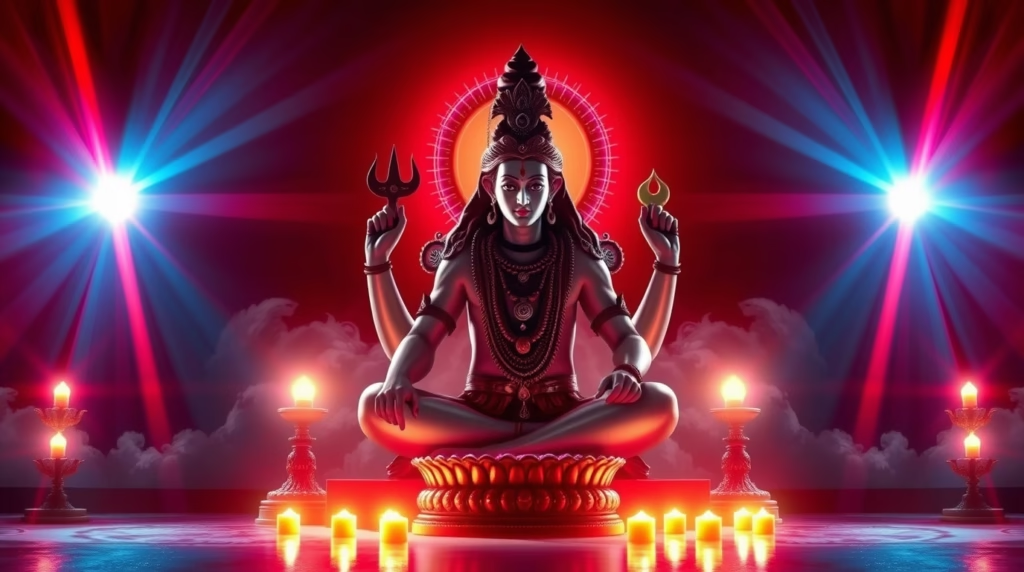
Maha Shivratri 2025: A Deep Dive into the Great Night of Shiva
An important Hindu holiday, Maha Shivratri, also known as the “Great Night of Shiva,” is devoted to Lord Shiva, one of the main gods in the Hindu pantheon.One Honored with passion and dedication, this auspicious occasion holds deep spiritual significance, symbolizing the union of the individual soul with the divine. This comprehensive guide delves into the intricacies of Maha Shivratri 2025, exploring its date, spiritual significance, rituals, timings, and diverse celebrations across India.
When is Maha Shivratri 2025?
Maha Shivratri is observed on the 13th or 14th night of the Krishna Paksha of the Hindu month of Phalguna, which typically corresponds to February or March in the Gregorian calendar. In 2025, Maha Shivratri falls on Wednesday, February 26th. This timing, just before the new moon, is considered particularly potent for spiritual practices.
The Profound Spiritual Significance of Maha Shivratri
Maha Shivratri’s significance is rooted in several compelling narratives. One prominent legend recounts how Lord Shiva, demonstrating immense compassion, consumed the poison that emerged from the churning of the cosmic ocean, saving the universe from destruction. He held the poison in his throat, which turned blue, earning him the name Neelkanth. This act symbolizes the triumph over negativity and the power of self-sacrifice.
Another tale narrates the reunion of Lord Shiva and Parvati. After the self-immolation of Sati, Shiva’s first wife, she was reborn as Parvati. Their divine union is celebrated on Maha Shivratri, signifying the cosmic dance of creation and the power of divine love.
Furthermore, Maha Shivratri is associated with the awakening of the Jyotirlinga, a manifestation of Lord Shiva in the form of a pillar of light. This symbolizes the divine presence within all beings. For ascetics and spiritual seekers, Maha Shivratri is also the day Shiva achieved stillness, becoming one with Mount Kailash, representing the ultimate state of peace and liberation.
Sadhguru, a renowned spiritual leader, explains that Mahashivratri is the darkest night of the month, yet it is a celebration of “that which is not” – Shiva, the vast emptiness that underlies all existence. This emptiness, or nothingness, is the source of all creation and the ultimate reality. It is in this context that Shiva is revered as Mahadeva, the great lord. Mahashivratri, therefore, becomes an opportunity to transcend our limitations and experience the unboundedness of the source of creation within us.
Observing Maha Shivratri: Rituals and Practices
Devotees observe Maha Shivratri with deep reverence and devotion. The day is typically marked by fasting, often with the consumption of only fruits and milk. Many devotees stay awake throughout the night, engaging in prayers, chanting, and meditation.
- Fasting: The fast is a symbolic gesture of self-discipline and devotion, purifying the body and mind.
- Puja and Abhishekam: Special pujas are conducted in Shiva temples, and the ritual of Rudrabhisheka is performed, where the Shiva Lingam is bathed with milk, honey, yogurt, and other sacred substances. Offerings of flowers, incense, and lamps are made to the deity.
- Chanting and Meditation: Chanting the sacred mantra “Om Namah Shivaya” is considered highly auspicious on this day. Meditation is also recommended to connect with the divine energy and experience inner peace.
- Nightlong Vigil: Staying awake throughout the night, known as ratri jagaran, is a significant aspect of the celebration. Devotees engage in devotional songs, stories, and discourses, keeping their minds focused on Lord Shiva.
Maha Shivratri 2025: Auspicious Timings
Understanding the precise timings for the rituals is essential for observing Maha Shivratri with utmost devotion. Here are the key timings for Maha Shivratri 2025:
- Sunrise: February 26, 6:54 AM
- Sunset: February 26, 6:24 PM
- Chaturdashi Tithi Timing: February 26, 11:08 AM – February 27, 8:55 AM
- Maha Shivaratri Parana Time (Breaking the Fast): February 27, 6:53 AM – 8:55 AM
- Nishita Kaal Puja Time: February 27, 12:14 AM – 1:04 AM
- Ratri First Prahar Puja Time: February 26, 6:24 PM – 9:32 PM
- Ratri Second Prahar Puja Time: February 26, 9:32 PM – February 27, 12:39 AM
- Ratri Third Prahar Puja Time: February 27, 12:39 AM – 3:46 AM
- Ratri Fourth Prahar Puja Time: February 27, 3:46 AM – 6:53 AM
Maha Shivratri Celebrations Across India
Maha Shivratri is celebrated with great enthusiasm throughout India, each region adding its unique flavor to the festivities. Some notable celebrations include:
- Kalahasteswara Temple (Andhra Pradesh): This ancient temple is renowned for its unique architecture and spiritual significance.
- Umananda Temple (Assam): Located on Peacock Island in the Brahmaputra River, this temple offers a serene and picturesque setting for the celebrations.
- Bhutnath Temple (Himachal Pradesh): Nestled in the Himalayas, this temple attracts devotees from far and wide.
- Matangeswar Temple (Madhya Pradesh): This temple is known for its impressive Shiva Lingam.
- Tarakeswar Temple (West Bengal): This temple is a major pilgrimage site, particularly during Maha Shivratri.
- Sidhlingappa’s Fair (Karnataka): This grand fair is a major attraction during Maha Shivratri, featuring various cultural performances and activities.
- Kashmir: In Kashmir, Maha Shivratri is celebrated as “Hayrath” or “Vatuk Puja,” with a tradition of exchanging gifts among Hindus.
Maha Shivratri: A Night of Transformation
Maha Shivratri is more than just a festival; it is a profound spiritual opportunity. It is a time to reflect on our lives, connect with the divine, and strive for self-realization. By understanding the significance of this sacred occasion and observing the rituals with sincerity and devotion, we can embrace the transformative power of Maha Shivratri and experience the grace of Lord Shiva. May this Maha Shivratri 2025 be a night of awakening for all, leading us towards inner peace, enlightenment, and union with the divine.
more news|| click here